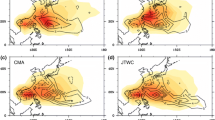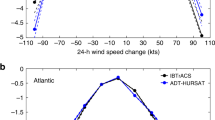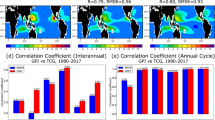Abstract
Recent modeling studies have consistently shown that the global frequency of tropical cyclones will decrease but that of very intense tropical cyclones may increase in the future warmer climate. It has been noted, however, that the uncertainty in the projected changes in the frequency of very intense tropical cyclones, particularly the changes in the regional frequency, is very large. Here we present a projection of the changes in the frequency of intense tropical cyclones estimated by a statistical downscaling of ensemble of many high-resolution global model experiments. The results indicate that the changes in the frequency of very intense (category 4 and 5) tropical cyclones are not uniform on the globe. The frequency will increase in most regions but decrease in the south western part of Northwest Pacific, the South Pacific, and eastern part of the South Indian Ocean.







Similar content being viewed by others
References
Arakawa A, Schubert WH (1974) Interaction of cumulus cloud ensemble with the large-scale environment. Part I. J Atmos Sci 31:674–701
IPCC (2013) Climate change 2013: the physical science basis. Stocker TF et al (eds) Cambridge University Press, Cambridge
Kain JS, Fritsch JM (1990) A one-dimensional entraining/detraining plume model and its application in convective parameterization. J Atmos Sci 47:2784–2802
Kain JS, Fritsch JM (1993) Convective parameterization for mesoscale models: the Kain–Fritsch scheme. In: Emanuel KA, Raymond DJ (eds) The representation of cumulus convection in numerical models of the atmosphere. Meteorol Monogr Am Meteorol Soc 46:165–170
Knutson TR et al (2010) Tropical cyclones and climate change. Nat Geosci 3:157–163. doi:10.1038/ngeo779
Knutson TR et al (2013) Dynamical downscaling projections of twenty-first-century Atlantic hurricane activity: CMIP3 and CMIP5 model-based scenario. J Clim 26:6591–6617. doi:10.1175/JCLI-D-12-00539.1
Knutson TR, Sirutis JJ, Zhao M, Tuleya RE, Bender MO, Vecchi GA, Villarini G, Chavas D (2015) Global projections of intense tropical cyclone activity for the late twenty-first century from dynamical downscaling of CMIP5/RCP4.5 scenarios. J Clim 28:7203–7224. doi:10.1175/JCLI-D-15-0129.1
Murakami H, Mizuta R, Shindo E (2012a) Future changes in tropical cyclone activity projected by multi-physics and multi-SST ensemble experiments using the 60-km-mesh MRIAGCM. Clim Dyn 39:2569–2584. doi:10.1007/s00382-011-1223-x
Murakami H et al (2012b) Future changes in tropical cyclone activity projected by the new high-resolution MRI-AGCM. J Clim 25:3237–3260. doi:10.1175/JCLI-D-11-00415.1
Murakami H et al (2015) Simulation and prediction of category 4 and 5 hurricanes in the high-resolution GFDL HiFLOR coupled climate model. J Clim 28:9058–9079. doi:10.1175/JCLI-D-15-0216.s1
Randall D, Pan D-M (1993) Implementation of the Arakawa–Schubert cumulus parameterization with a prognostic closure. The representation of cumulus convection in numerical models. Meteorol Monogr Am Meteorol Soc 46:137–144
Roberts M et al (2015) Tropical cyclones in the UPSCALE ensemble of high-resolution global climate models. J Clim 28:574–596. doi:10.1175/JCLI-D-14-00131.1.s1
Rayner NA, Parker DE, Horton EB, Folland CK, Alexander LV, Rowell DP (2003) Global analyses of sea surface temperature, sea ice, and night marine air temperature since the late nineteenth century. J Geophys Res 108:4407. doi:10.1029/2002JD002670
Sugi M, Yoshimura J (2012) Decreasing trend of tropical cyclone frequency in 228-year high-resolution AGCM simulations. Geophys Res Lett 39:L19805. doi:10.1029/2012GL053360
Unisys (2012) Unisys weather hurricane tropical data. http://weather.unisys.com/hurricane/
Walsh K et al (2016) Tropical cyclones and climate change. WIRES Clim Change 7:65–89. doi:10.1002/wcc.371
Wehner M, Prabhat Reed KA, Stone D, Collins WD, Bacmeister J (2015) Resolution dependence of future tropical cyclone projections of CAM5.1 in the U. S. CLIVAR Hurricane Working Group idealized configurations. J Clim 28:3905–3924. doi:10.1175/JCLI-D-14-00311.1
Yoshimura H, Mizuta R, Murakami H (2015) A spectral cumulus parameterization scheme interpolating between two convective updrafts with semi-Lagrangian calculation of transport by compensatory subsidence. Mon Wea Rev 143:597–621. doi:10.1175/MWR-D-14-00068.1
Zhao M, Held IM (2010) An analysis of the effect of global warming on the intensity of Atlantic hurricanes using a GCM with statistical refinement. J Clim 23:6382–6393. doi:10.1175/2010JCLI3837.1
Acknowledgments
This work was conducted under the framework of the Program for Risk Information on Climate Change (SOUSEI program) and Innovative Program of Climate Change Projection for the twenty first Century (KAKUSHIN Program) of the Ministry of Education, Culture, Sports, Science and Technology (MEXT) of Japan. Calculations were performed on the Earth Simulator of JAMSTEC.
Author information
Authors and Affiliations
Corresponding author
Additional information
An erratum to this article is available at http://dx.doi.org/10.1007/s00382-017-3612-2.
Rights and permissions
About this article
Cite this article
Sugi, M., Murakami, H. & Yoshida, K. Projection of future changes in the frequency of intense tropical cyclones. Clim Dyn 49, 619–632 (2017). https://doi.org/10.1007/s00382-016-3361-7
Received:
Accepted:
Published:
Issue Date:
DOI: https://doi.org/10.1007/s00382-016-3361-7




